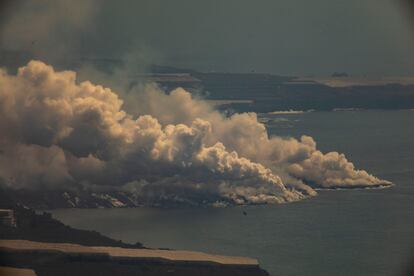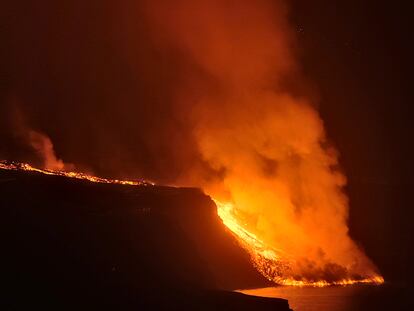Volcanic eruption intensifies in La Palma, increasing ash fall
The lava flowing into the sea has already added around 17.2 hectares of surface area to the Spanish island


The Cumbre Vieja volcano in La Palma, in Spain’s Canary Islands, on Thursday increased its eruptive force and was emitting a greater quantity of ash than when its lava reached the sea on Tuesday night, sources from the National Geographic Institute (IGN) confirmed. They warned that explosions are now being registered in the north slope of the main cinder cone. This new situation could cause the cone to collapse in the short term, something that is within the forecasts of the volcanologists who are working on the island.
The team of experts monitoring the phenomenon, the Volcano Risk Prevention Plan (Pevolca), has not seen evidence that the “dynamic of the eruption process is at all stable,” as they warned yesterday. For this reason, sea and land exclusion zones remained in place on Thursday, as did the evacuation of residents and the lockdown in the areas of San Borondón, Marina Alta, Marina Baja and La Condesa.
“We are carrying out studies and monitoring constantly and until we know which areas are out of risk, these measures will remain in place,” explained the technical director of Pevolca, Rubén Fernández. It was still unclear on Thursday how dangerous the gases were that have been emanating from the sea since the lava met the ocean. The IGN stated that the reach of the gases was limited to the area where the molten rock met the ocean.
Meanwhile, the eruption continued to increase the surface area of the island on Thursday. The outfall of the lava on what used to be Guirre beach now measures 17.2 hectares, meaning that it has grown three times compared to the official data released at midday on Tuesday.

The latest estimates from the European Union’s Copernicus satellite program, from this Wednesday, calculate that the area that has been destroyed by the lava and gained in the sea is now 338.3 hectares, while a total of 1,752.8 hectares is covered in ash. The total number of buildings affected by the lava is now 981, of which 855 have been destroyed. What’s more, the molten rock has reached 29.8 kilometers of roads, 27.4 kilometers of which have been completely buried.
The volcano has been emitting nearly 17,000 tons of sulfur dioxide a day, and the average height of the column of ash and gases has been 3.5 kilometers. Underground, the tremors continued. “The seismic activity continues to be located, principally, near [the same location where it was] during the first days, at depths greater than 10 kilometers,” Pevolca reported on Wednesday. “From the tremors located on Wednesday, six were above a magnitude of 3 [...]. There were also some superficial quakes around the cone eruption.”
The lava was moving today at a speed of two meters per hour, according to Science Minister Diana Morant, who was speaking to TV network Antena 3. That’s compared to a speed of up to 700 meters per hour just a few days ago. That said, the direction of the tongues of lava is still unclear. The molten rock was still entering the sea in the same place it first arrived on Tuesday night, but it could still take a new route. “Making long-term predictions in a case like this is difficult,” she said.
Vulcanologist Ramón Casillas, a member of the scientific committee for the emergency team and a professor from the University of La Laguna, explained that it’s “a bit of a myth” that the lava could stay stable now on that route. “In actual fact it doesn’t have to be like that, the lava could flow into other places and abandon that channel,” he said. “It is true that the main flow is located there, but there are other points where the lava is still moving,” he added.
At the same time, the authorities were trying to help the victims of the eruption as much as possible. On Thursday, some residents were given authorization to collect belongings, provided they were outside the 2.5-kilometer exclusion zone. Agricultural workers were also permitted to enter plots of land in El Remo, Puerto Naos and Las Hoyas for watering purposes and to collect bunches of bananas.
English version by Simon Hunter.
Tu suscripción se está usando en otro dispositivo
¿Quieres añadir otro usuario a tu suscripción?
Si continúas leyendo en este dispositivo, no se podrá leer en el otro.
FlechaTu suscripción se está usando en otro dispositivo y solo puedes acceder a EL PAÍS desde un dispositivo a la vez.
Si quieres compartir tu cuenta, cambia tu suscripción a la modalidad Premium, así podrás añadir otro usuario. Cada uno accederá con su propia cuenta de email, lo que os permitirá personalizar vuestra experiencia en EL PAÍS.
¿Tienes una suscripción de empresa? Accede aquí para contratar más cuentas.
En el caso de no saber quién está usando tu cuenta, te recomendamos cambiar tu contraseña aquí.
Si decides continuar compartiendo tu cuenta, este mensaje se mostrará en tu dispositivo y en el de la otra persona que está usando tu cuenta de forma indefinida, afectando a tu experiencia de lectura. Puedes consultar aquí los términos y condiciones de la suscripción digital.
More information
Últimas noticias
Nazareth Castellanos, neuroscientist: ‘We need to teach anxiety prevention techniques from school onwards’
Oona Chaplin: ‘I told James Cameron that I was living in a treehouse and starting a permaculture project with a friend’
Madrid, the second region in Europe with the most roundabouts thanks to urban speculation: One for every 30 intersections
Amy Taylor, singer of Amyl and the Sniffers: From selling nuts to opening for AC/DC
Most viewed
- Charles Dubouloz, mountaineering star, retires at 36 with a farewell tour inspired by Walter Bonatti
- CBS in crisis after pulling a report on Trump’s deportations to El Salvador (which later leaked online)
- December Social Security and SSI payments: Dates, double checks and the 2026 COLA increase
- Venezuela faces its most tense Christmas yet
- Bukele clan fumes over investigation exposing their new wealth










































